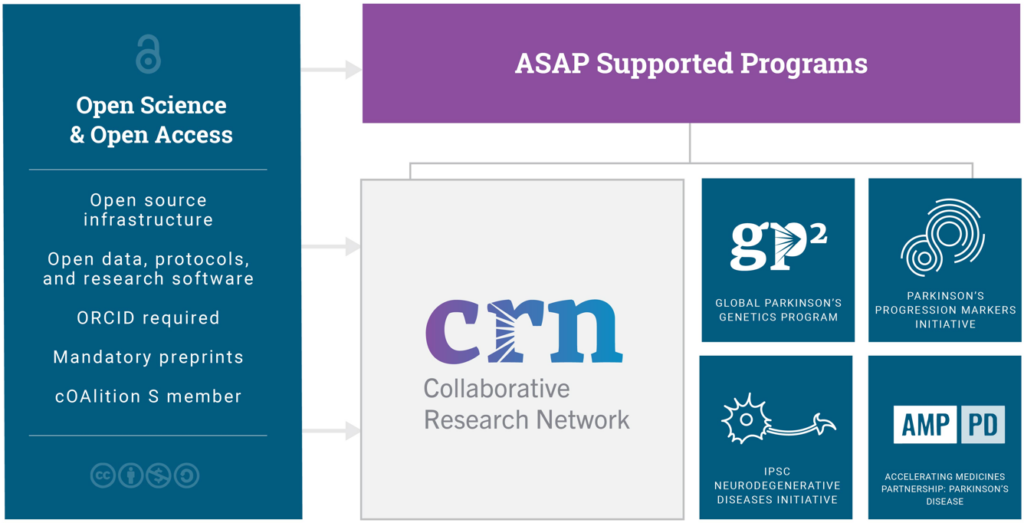Aligning Science Across Parkinson’s (ASAP) is a research program focused on understanding the underlying science of Parkinson’s disease (PD) with the goal of amplifying and coordinating efforts around the world within and outside the existing PD community. Our initiative is unique due to our ability to make large, long-term commitments; our appetite for risk and ability to support studies that might otherwise not be funded; and our steadfast belief that we can accelerate advances by fostering a collaborative and open approach to research through our open science policies. We are managed by the Coalition for Aligning Science (CAS) and collaborate with The Michael J. Fox Foundation for Parkinson’s Research (MJFF) to implement our programs. We invite you to learn more about our impact.
Our Commitment to Open Science
At ASAP, we use the principles of open science to support the larger goals of collaboration, resource generation, and data sharing and accessibility to make a positive impact on PD research.

We support five programs, all with the goal of advancing research for the benefit of the entire PD community. These projects help fuel mechanistic research and enable biomarker studies. They work together to help us and the PD research field move closer to accelerating scientific advances by fostering a collaborative and open approach to research through open science.
ASAP Theory of Change
At ASAP, we apply a Theory of Change framework, which allows us to cohesively and comprehensively measure progress – from idea to result – in the context of our overarching vision. Further, it enables us to reflect upon and iterate processes as we measure our progress to date. Our work is broken down into the three main components of our mission: collaboration, resource generation, and data sharing, which underpin our strategies for accelerating discoveries for PD.
SUPPORT COLLABORATION
Scientific progress can be accelerated when researchers exchange ideas early and often, in a collaborative rather than competitive manner.
GENERATE RESOURCES
By supporting resource development, we are building an infrastructure, available to the larger scientific community, that improves access to research tools, reproducibility of studies, and process efficiency to accelerate discoveries.
SHARE DATA
By sharing research outputs like data, code, and protocols, we are allowing researchers to build upon the work of others. This facilitates collaboration among investigators, attracts new talent and expertise to the field, and allows us to increase the power of our studies through meta-analysis.
ACCELERATE DISCOVERIES
We believe that by supporting collaboration, facilitating research, enabling resource generation, and creating a culture of data sharing, we can deliver faster and better outcomes for Parkinson’s disease research.
Open science is at the core of all our work. We are committed to ensuring research outputs are distributed online, free of cost or other access barriers. We facilitate the rapid and free exchange of scientific ideas, ensuring that the research we fund can be leveraged for future discoveries. Learn more about our comprehensive report, the ASAP Blueprint, our recent publication, and other open science engagements.
ASAP by the Numbers
as of October 2024
2,054
Research Outputs
444
Articles
5.5
Average Months Between Preprints and Published Outputs
8
GP2 Data Releases
209
CRN Datasets
17 million+
PPMI Data Downloads
106
Software/Code
881
Protocols
381
CRN Lab Materials
9
iNDI-PD Lab Resources
Our Catalog lists ASAP-funded research outputs, including blog posts, articles, protocols, datasets, code for analytical pipelines, and lab resources such as plasmids, cell lines, or animal models.
Protocol Particulars
Check out our interview series with ASAP-funded researchers explaining the process to recreate their protocols and sharing best practices.
Introducing the Tagless LysoIP Method with Daniel Saarela, BSc
Daniel Saarela, BSc
Team Alessi
Pulling back the CURTAIN on Mass Spec Dataset Exploration with Enrico Bagnoli, PhD
Enrico Bagnoli, PhD
Team Alessi
Latest News
Parkinson’s News Today reports on the ASAP CRN Cloud, a data-sharing platform that will make data on human brain samples available to researchers around the world.


